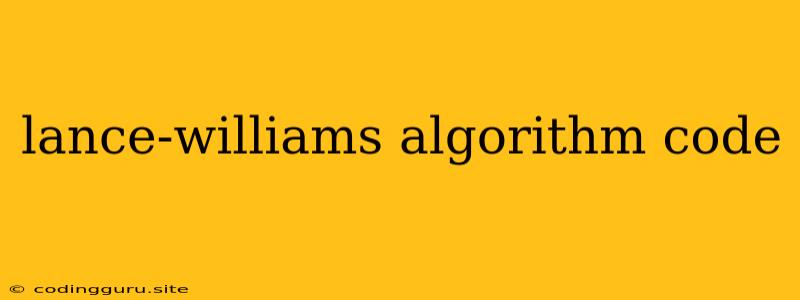Understanding the Lance-Williams Algorithm: A Comprehensive Guide
The Lance-Williams Algorithm is a powerful tool used in hierarchical clustering, particularly in the context of agglomerative clustering. This algorithm provides an efficient way to update the distance matrix as clusters are merged, significantly reducing computational costs. But how does it work, and what are its key benefits? Let's delve into the details.
What is the Lance-Williams Algorithm?
Imagine you have a dataset of data points, and you want to group them into clusters based on their similarity. The Lance-Williams Algorithm provides a mechanism for calculating the distance between two newly merged clusters based on the distances between the original clusters. This is crucial because instead of recalculating the entire distance matrix after each merge, it leverages the existing distances to update the matrix efficiently.
How does the Lance-Williams Algorithm work?
The algorithm relies on a formula to update the distance between two clusters (C1 and C2) after they are merged to form a new cluster (C12):
d(C12, Cj) = α1 * d(C1, Cj) + α2 * d(C2, Cj) + β * d(C1, C2) + γ * |d(C1, Cj) - d(C2, Cj)|
Where:
- d(C1, Cj) represents the distance between cluster C1 and any other cluster Cj.
- d(C2, Cj) represents the distance between cluster C2 and any other cluster Cj.
- d(C12, Cj) represents the distance between the merged cluster C12 and any other cluster Cj.
- α1, α2, β, and γ are coefficients that define the specific linkage method used.
Different Linkage Methods:
The Lance-Williams Algorithm provides flexibility through its coefficients, allowing for different linkage methods that define how distances between clusters are calculated:
- Single Linkage: This method uses the minimum distance between any two points in the two clusters. The coefficients would be (α1, α2, β, γ) = (1/2, 1/2, 0, 0).
- Complete Linkage: This method uses the maximum distance between any two points in the two clusters. The coefficients would be (α1, α2, β, γ) = (1/2, 1/2, 0, 0).
- Average Linkage: This method uses the average distance between all pairs of points in the two clusters. The coefficients would be (α1, α2, β, γ) = (n1/(n1+n2), n2/(n1+n2), 0, 0) where n1 and n2 are the number of points in clusters C1 and C2 respectively.
- Centroid Linkage: This method uses the distance between the centroids of the two clusters. The coefficients would be (α1, α2, β, γ) = (n1/(n1+n2), n2/(n1+n2), -n1*n2/((n1+n2)^2), 0).
- Ward's Linkage: This method minimizes the variance within the clusters. The coefficients are more complex and involve the number of points in each cluster and their variances.
Advantages of using the Lance-Williams Algorithm:
- Efficiency: The algorithm significantly reduces the computational complexity of hierarchical clustering, especially for large datasets. Instead of recalculating the entire distance matrix after each merge, it uses the existing distances to update the matrix efficiently.
- Flexibility: The algorithm supports various linkage methods, allowing you to choose the most suitable one for your specific data and clustering goals.
- Simplicity: The algorithm is relatively easy to implement and understand, making it accessible to a wide range of users.
Example Implementation:
Let's illustrate with a simple example using Python:
import numpy as np
def lance_williams(dist_matrix, cluster1, cluster2, linkage='single'):
"""
Updates the distance matrix using the Lance-Williams algorithm.
Args:
dist_matrix: The distance matrix.
cluster1: The first cluster to merge.
cluster2: The second cluster to merge.
linkage: The linkage method to use. Options: 'single', 'complete', 'average', 'centroid', 'ward'.
Returns:
The updated distance matrix.
"""
merged_cluster = (cluster1, cluster2)
n1 = len(cluster1)
n2 = len(cluster2)
if linkage == 'single':
alpha1 = 1/2
alpha2 = 1/2
beta = 0
gamma = 0
elif linkage == 'complete':
alpha1 = 1/2
alpha2 = 1/2
beta = 0
gamma = 0
elif linkage == 'average':
alpha1 = n1 / (n1 + n2)
alpha2 = n2 / (n1 + n2)
beta = 0
gamma = 0
elif linkage == 'centroid':
alpha1 = n1 / (n1 + n2)
alpha2 = n2 / (n1 + n2)
beta = -n1 * n2 / ((n1 + n2)**2)
gamma = 0
elif linkage == 'ward':
# More complex calculation for Ward's linkage, omitted for brevity
pass
else:
raise ValueError("Invalid linkage method.")
for j in range(dist_matrix.shape[0]):
if j not in merged_cluster:
dist_matrix[merged_cluster, j] = alpha1 * dist_matrix[cluster1, j] + alpha2 * dist_matrix[cluster2, j] + beta * dist_matrix[cluster1, cluster2] + gamma * abs(dist_matrix[cluster1, j] - dist_matrix[cluster2, j])
return dist_matrix
# Example usage:
# Assuming you have a distance matrix 'dist_matrix' and two clusters 'cluster1' and 'cluster2'
updated_dist_matrix = lance_williams(dist_matrix, cluster1, cluster2, linkage='average')
Conclusion:
The Lance-Williams Algorithm offers a computationally efficient and versatile approach for updating distance matrices in hierarchical clustering. It allows for different linkage methods, providing flexibility in defining the distance between clusters based on your specific data and clustering goals. Understanding its workings and its different linkage methods empowers you to leverage this algorithm for effective hierarchical clustering analysis.
